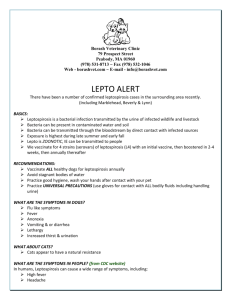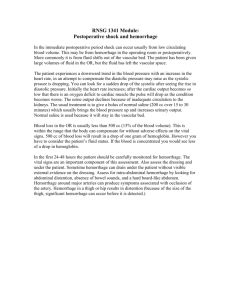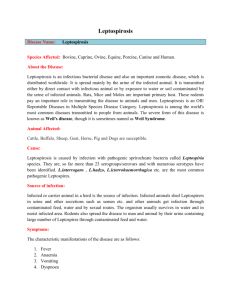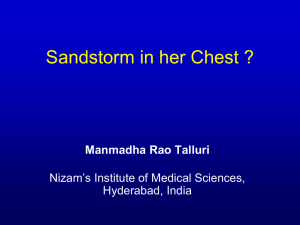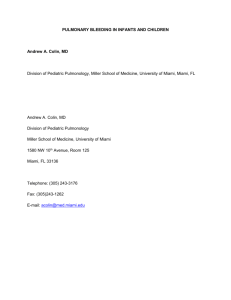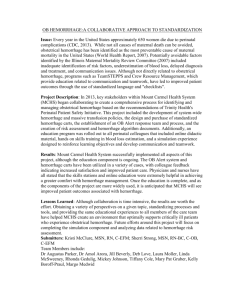Leptospirosis Presenting as Diffuse Alveolar Hemorrhage Dr Mary
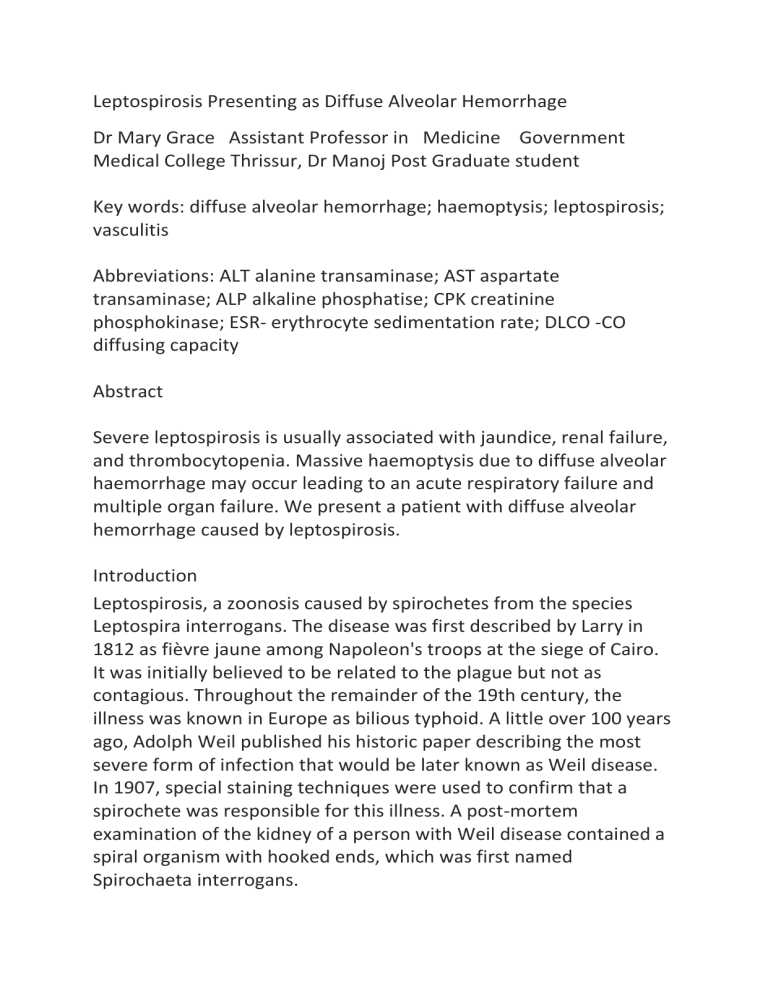
Leptospirosis Presenting as Diffuse Alveolar Hemorrhage
Dr Mary Grace Assistant Professor in Medicine Government
Medical College Thrissur, Dr Manoj Post Graduate student
Key words: diffuse alveolar hemorrhage; haemoptysis; leptospirosis; vasculitis
Abbreviations: ALT alanine transaminase; AST aspartate transaminase; ALP alkaline phosphatise; CPK creatinine phosphokinase; ESR- erythrocyte sedimentation rate; DLCO -CO diffusing capacity
Abstract
Severe leptospirosis is usually associated with jaundice, renal failure, and thrombocytopenia. Massive haemoptysis due to diffuse alveolar haemorrhage may occur leading to an acute respiratory failure and multiple organ failure. We present a patient with diffuse alveolar hemorrhage caused by leptospirosis.
Introduction
Leptospirosis, a zoonosis caused by spirochetes from the species
Leptospira interrogans. The disease was first described by Larry in
1812 as fièvre jaune among Napoleon's troops at the siege of Cairo.
It was initially believed to be related to the plague but not as contagious. Throughout the remainder of the 19th century, the illness was known in Europe as bilious typhoid. A little over 100 years ago, Adolph Weil published his historic paper describing the most severe form of infection that would be later known as Weil disease.
In 1907, special staining techniques were used to confirm that a spirochete was responsible for this illness. A post-mortem examination of the kidney of a person with Weil disease contained a spiral organism with hooked ends, which was first named
Spirochaeta interrogans.
Dark field microscopy of leptospiral microscopic agglutination test.
Case history
A 53 year old male presented with history of fever of 4 days duration associated with severe myalgia , haemoptysis, dyspnoea and yellow discolouration of urine. He had normal urine output. His past medical history was unremarkable. On examanitation he was tachypnoeic with a respiratory rate of 40/ minute. He had icterus, myalgia, enlarged liver 3 cm below the right costal margin. His blood pressure was 130/80 mm of Hg, and pulse rate was 100/minute and his temperature was 100°F. He had normal vesicular breath sounds and no added sounds.
Investigations revealed haemoglobin of 11.6 g%, leucocytosis with raised ESR (Total count 17,900, polymorphs 74%, lymphocytes
24% ESR 112).He had thrombocytopenia (platelet count
11,000/mm3). Urinalysis revealed trace protein, 8 to 10 WBCs, and no casts. He had deranged renal function (blood urea 67 mg% and serum creatinine 1.7 mg%).He had total bilirubin of 4.2 mg% with conjugated fraction of 2.6mg% SGOT 100 units (normal < 40 U/L ) and SGPT 208 (normal < 40U/L) and ALP 161 units, CPK 511 units. His
X-ray showed bilateral nodular opacities suggestive of alveolar haemorrhages.
Pulmonary function test revealed DLCO of 47.12 ml/min/mmHg/L (predicted value 26.31, patient’s value was 179% of the predicted ). His sputum AFB was negative and sputum culture showed normal flora. He had raised IGM leptospiral antibody titres. With a clinical diagnosis of leptospirosis, hepatorenal involvement and pulmonary involvement in the form of diffuse alveolar hemorrhage, he was started on injection crystalline penicillin and methyl prednisolone .He was also given platelet transfusions and symptomatic treatment. He improved over a period of one week with improvement in platelet count, transaminases, renal function tests and radiological signs.
Discussion
Pulmonary symptoms are usually mild in leptospirosis. Pulmonary symptoms include chest pain secondary to myositis or pleurisy, cough, haemoptysis and diffuse pulmonary hemorrhage. (1) Alveolar hemorrhage is a grave pulmonary manifestation. The syndrome of diffuse alveolar hemorrhage consists of haemoptysis, bilateral airspace opacification on the chest radiograph, and a decreased hematocrit secondary to bleeding from the pulmonary microvasculature into the alveolar space. Alveolar hemorrhage can occur in the absence of typical manifestations of Weil’s disease.
Respiratory system examination may be normal in mild illness. In severe illness, signs of consolidation due to alveolar hemorrhage may be found. Radiographic findings commonly accompany pulmonary symptoms but may occur without them. The radiographic changes appear as early as 24 h after symptoms begin, although more
commonly 3 to 9 days later. Three radiographic patterns occur: (1) small “snowflake-like” nodular densities corresponding to areas of alveolar hemorrhage, (2) large confluent consolidations, and (3) a diffuse, ill-defined ground-glass pattern that may represent resolving hemorrhage. (2) Serial radiographs may show progression from a nodular pattern to confluent consolidation. Pulmonary involvement is secondary to alveolar and interstitial vascular damage resulting in hemorrhage. Pulmonary involvement has emerged as a serious cause of mortality in leptospirosis.
Leptospira cause disease through a toxin-mediated process by inducing vascular injury, particularly a small-vessel vasculitis. The specific toxin responsible remains unidentified, but possibilities include outer membrane proteins, membrane glycolipoproteins, haemolysins, and lipopolysaccharides. The vasculitis producing pulmonary hemorrhage primarily affects capillaries. Diffuse petechiae involve the lung parenchyma, pleural surfaces, and tracheobronchial tree. (3) Microscopic examination usually demonstrates areas of intra-alveolar and interstitial hemorrhage, but other findings, including pulmonary edema, fibrin deposition, hyaline membrane formation, and proliferative fibroblastic reactions, are frequent. Leptospira are uncommon in the lung tissue, although leptospiral antigen is present at sites of tissue injury. Inflammatory infiltrates are generally not prominent. Electron microscopic studies reveal the primary lesion as damage to the capillary system: endothelial cells swell and detach from the basement membrane leaving areas of exposed interstitium, even in areas free of hemorrhage.
The use of the corticosteroid therapy has already been described in the management of pulmonary leptospirosis. In a series of 30 patients, Shenoy et al. demonstrated that corticosteroids reduce mortality and changed outcome significantly. (4) Platelet transfusions and desmopressin therapy has proved to be effective in
massive pulmonary hemorrhage. (5) A recent publication mentions the use of cyclophosphamide in patients with leptospiral pulmonary alveolar hemorrhage: out of the 33 patients treated with cyclophosphamide, 22 (66.7%) survived, while in the control group out of 32 patients, three (9.4%) survived. The hypothesis is that an exacerbated immune response of the host plays an important role in its pathogenesis. (6)
References.
1 Andrew M. Luks. Leptospirosis Presenting as Diffuse Alveolar
Hemorrhage. Chest 2003; 123:639-643
2 Im JG, et al. Leptospirosis of the lung: radiographic findings in 58 patients. AJR Am J Roentgenol gy 1989; 152:955–959
3 Arean VM. The pathologic anatomy and pathogenesis of fatal human leptospirosis (Weil’s disease). Am J Pathol 1962; 40:393–423
4 V. V. Shenoy, et al. “Pulmonary leptospirosis: an excellent response to bolus methylprednisolone,” Postgraduate Medical
Journal 2006; 82: 602–606
5 L. Pea, et al. “Desmopressin therapy for massive haemoptysis associated with severe leptospirosis,” American Journal of
Respiratory and Critical Care Medicine 2003; 167: 726–728
6 S. V. Trivedi, et al. “Cyclophosphamide in pulmonary alveolar hemorrhage due to leptospirosis,” Indian Journal of Critical Care
Medicine 2009; 13: 79–84

